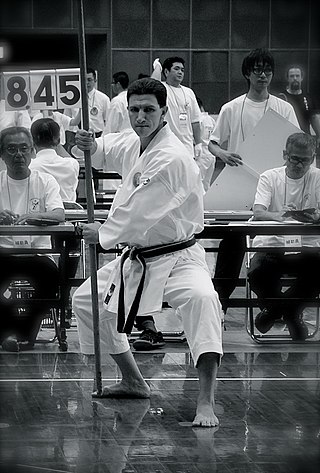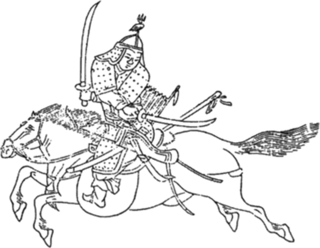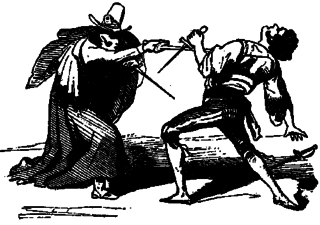| Dangpa | |
 |
| Dangpa | |
 |

A polearm or pole weapon is a close combat weapon in which the main fighting part of the weapon is fitted to the end of a long shaft, typically of wood, extending the user's effective range and striking power. Polearms are predominantly melee weapons, with a subclass of spear-like designs fit for thrusting and/or throwing. Because many polearms were adapted from agricultural implements or other fairly abundant tools, and contained relatively little metal, they were cheap to make and readily available. When belligerents in warfare had a poorer class who could not pay for dedicated military weapons, they would often appropriate tools as cheap weapons. The cost of training was comparatively low, since these conscripted farmers had spent most of their lives using these "weapons" in the fields. This made polearms the favoured weapon of peasant levies and peasant rebellions the world over.
A spear is a pole weapon consisting of a shaft, usually of wood, with a pointed head. The head may be simply the sharpened end of the shaft itself, as is the case with fire hardened spears, or it may be made of a more durable material fastened to the shaft, such as bone, flint, obsidian, copper, bronze, iron, or steel. The most common design for hunting and/or warfare, since ancient times has incorporated a metal spearhead shaped like a triangle, lozenge, or leaf. The heads of fishing spears usually feature multiple sharp points, with or without barbs.

The nunchaku, "nunchucks", "chainsticks", or "chuka sticks" in English,) is a traditional Asian martial arts weapon consisting of two sticks, connected to each other at their ends by a short metal chain or a rope. It is approximately 30 cm (12") (sticks) and 1 inch (rope). A person who has practiced using this weapon is referred to in Japanese as nunchakuka.
The pilum was a javelin commonly used by the Roman army in ancient times. It was generally about 2 m long overall, consisting of an iron shank about 7 mm (0.28 in) in diameter and 600 mm (24 in) long with a pyramidal head, attached to a wooden shaft by either a socket or a flat tang.

A trident is a three-pronged spear. It is used for spear fishing and historically as a polearm.

The sai is a traditional Okinawan melee weapon used for stabbing, striking and disarming opponents. It is primarily used in ninjutsu and kobudō, as well as in southern Chinese martial arts. The basic form of the weapon is that of a sharp metal prong with two sharp and curved side prongs (yoku) projecting from the handle (tsuka). There are many different types of sai with varying prongs for trapping and blocking.

The épée, sometimes spelled epee in English, is the largest and heaviest of the three weapons used in the sport of fencing. The modern épée derives from the 19th-century épée de combat, a weapon which itself derives from the French small sword.

Swordsmanship or sword fighting refers to the skills and techniques used in combat and training with any type of sword. The term is modern, and as such was mainly used to refer to smallsword fencing, but by extension it can also be applied to any martial art involving the use of a sword. The formation of the English word "swordsman" is parallel to the Latin word gladiator, a term for the professional fighters who fought against each other and a variety of other foes for the entertainment of spectators in the Roman Empire. The word gladiator itself comes from the Latin word gladius, which is a type of sword.

A buckle or clasp is a device used for fastening two loose ends, with one end attached to it and the other held by a catch in a secure but adjustable manner. Often taken for granted, the invention of the buckle was indispensable in securing two ends before the invention of the zipper. The basic buckle frame comes in a variety of shapes and sizes depending on the intended use and fashion of the era. Buckles are as much in use today as they have been in the past: used for much more than just securing ones belt, instead they are one of the most dependable devices in securing a range of items.

A pitchfork or hay fork is an agricultural tool used to pitch loose material, such as hay, straw, manure, or leaves. It has a long handle and usually two to five thin tines designed to efficiently move such materials.

A jitte or jutte is a specialized weapon that was used by police in Edo-period Japan (1603–1868).

The Joseon Navy was the navy of the Korean dynasty of Joseon. While originally commissioned to protect merchant vessels and coastal towns from Japanese pirate raids, the Joseon navy is best known for defeating the Japanese naval forces during the Imjin War and is often credited with halting the Japanese invasion campaign and saving the dynasty from conquest.

Okinawan Kobudō (沖縄古武道), literally "old martial way of Okinawa", is the weapon systems of Okinawan martial arts.

Panokseon (Korean: 판옥선) was a class of Korean oar- and sail-propelled ship that was the main class of warship used by Joseon during the late 16th century. The first ship of this class was constructed in 1555. These ships were built from sturdy pine wood and, as the primary warship of the Korean Navy, they were instrumental in victories under the command of Admiral Yi Sun-shin against numerically larger Japanese fleets during the 1592-1598 Japanese invasions of Korea.

Commissioned in 1790 by King Jeongjo, the Muyedobotongji expanded on the eighteen weapons systems identified in the Muyeshinbo of 1758.

The parrying dagger is a category of small handheld weapons from the European late Middle Ages and early Renaissance. These weapons were used as off-hand weapons in conjunction with a single-handed sword such as a rapier. As the name implies they were designed to parry, or defend, more effectively than a simple dagger form, typically incorporating a wider guard, and often some other defensive features to better protect the hand as well. They may also be used for attack if an opportunity arises. The general category includes two more specific types, the sword breaker and trident dagger.
The dory or doru is a spear that was the chief spear of hoplites in Ancient Greece. The word "dory" was first attested by Homer with the meanings of "wood" and "spear". Homeric heroes hold two dorata. In the Homeric epics and in the classical period the dory was a symbol of military power, possibly more important than the sword, as can be inferred from expressions like "Troy conquered by dory" and words like "doryktetos" (spear-won) and "doryalotos" (spear-taken).

The Jixiao Xinshu or New Treatise on Military Efficiency is a military manual written during the 1560s and 1580s by the Ming dynasty general Qi Jiguang. Its primary significance is in advocating for a combined arms approach to warfare using five types of infantry and two type of support. Qi Jiguang separated infantry into five separate categories: firearms, swordsmen, archers with fire arrows, ordinary archers, and spearmen. He split support crews into horse archers and artillery units. The Jixiao Xinshu is also one of the earliest-existing East Asian texts to address the relevance of Chinese martial arts with respect to military training and warfare. Several contemporary martial arts styles of Qi's era are mentioned in the book, including the staff method of the Shaolin temple.

Listed here are the weapons of pencak silat. The most common are the machete, staff, kris, sickle, spear, and kerambit. Because Southeast Asian society was traditionally based around agriculture, many of these weapons were originally farming tools.

Indonesian martial arts includes a variety of fighting systems native to or developed in the archipelago of Indonesia, both the age-old traditional arts, and the more recently developed hybrid combatives. In the Indonesian language the term bela-diri is used to mean martial art, and in essence the Indonesian fighting arts are meant as one's defence against perceived threat and assault. Other than physical training, they often include spiritual aspects to cultivate inner strength, inner peace and higher psychological ends.